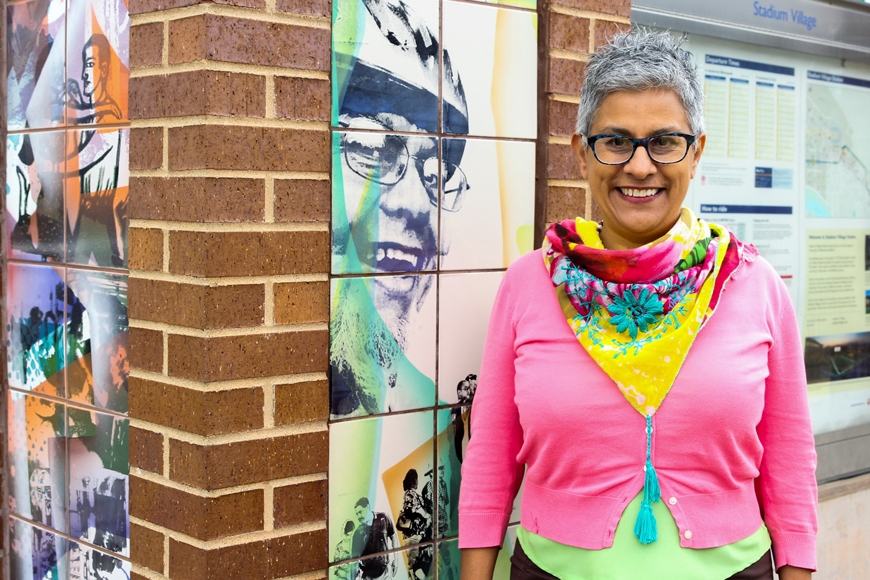Rhizomes of Change: History, Art, and Belonging
In early 2015, Karen Mary Davalos wrote a book covering 50 years of Chicano/a art based on information she had gathered by interviewing artists across the United States. Her text exceeded the publisher’s page limit and she had to cut out some of her content. It was clear that the history of Mexican American art could never fit into one book.
At the same time, she was aware that only a very small amount of Mexican American art has been digitized or even written about online, which means that a basic Google search on the topic tells a skewed story. The rich history of Mexican American art is virtually unavailable to students, scholars, and educators looking only to online resources.
To confront these issues, Davalos brainstormed unconventional methods to house art and make it more accessible. It finally dawned on her: what if she created a digital platform bringing together all known collections of Mexican American art while also including lesser-known artists across the country?
It was this groundbreaking idea that brought Davalos to the University of Minnesota as newly appointed chair of the Department of Chicano & Latino Studies.
Art Uncovered
As the first step of her project, Davalos started investigating Mexican American art in museums and archives across the US. Her findings were astonishing. “We did a landscape analysis and identified 87 institutions that have content on Mexican American art. They are all across the country, ranging from Illinois to Alabama.” Davalos and other scholars had no idea collections of Mexican American art were already featured in so many museums and archives.
That discovery illustrates a major problem with the current system. Each institution’s collections are individualized with a lack of communication between the different museums and archives. “By creating a virtual portal that connects them, we break out of this silo mentality that we get from colonial history,” says Davalos.
For this reason, Davalos named her initiative “Rhizomes: Mexican American Art Since 1848.” A rhizome is a root system that extends both horizontally and vertically. “We want this metaphor because it describes connections,” says Davalos. “We see the digital portal as a means to connect institutions to one another and we also want to strengthen communication across institutions themselves. Each archive or museum may have information they can share.”
Breaking Down Barriers
When considering how the digital portal would work, Davalos knew it would have to include some key components.
First, it needed to be accessible and interdisciplinary. “We are excited about making this database a shareable, searchable platform to help people find things from over 170 years ago to the present,” she explains. “We will use the collections that are out there, but will also build new material.”
Davalos conversed with several museums across the country, including the Smithsonian in Washington DC and National Hispanic Cultural Center in New Mexico. So far these conversations have been productive and Davalos hopes to connect these institutions with others through the database project.
The next step is creating a culturally informed catalog system for identifying and organizing Mexican American art pieces. The methods currently used to categorize art are not intuitive to scholars of Mexican American art. For example, work done by Mexican Americans is often classified under “work” or “labor” simply because the work was created by Mexican artists. As Davalos explains, “it’s all about increasing discovery and also challenging the categories that we get from western expectations of art and art practice. There are some racialized expectations that limit how people think about art, and we hope our platform will break through those things.”
Bringing the Portal to Life
As Davalos finishes the planning stage of this project she will work to implement, design, and beta-test the digital portal.
Portal users will be able to view pictures of every art piece in the dataset and each individual artifact will include links to the museum or archive where it is housed. This virtually connects users to the physical institutions where the art is located, which will bring more visitors to these museums. The portal will ultimately be accessible on all platforms, including phones, computers, and tablets.
Davalos’ goal is for the portal to catalog 200,000 artifacts, making it the largest known collection of Mexican American art. This archive will be crucial in aiding researchers and scholars to draw new conclusions about Mexican American art.
Davalos reiterates the important social impact of adding new art pieces to the existing dataset. “We are battling right now who belongs in this country. I want a platform that can say both historically, across space, and across this country that Mexican Americans have always been here and have always been contributing,” she says.
The portal will eliminate single, stereotyped narratives of Mexican American art, and dive deeper into the nuances and unique differences each Chicano/a artist has contributed to American art.
“It will give us a more capacious way of understanding American history, American art, and American belonging.”
This story was written by an undergraduate student content creator in CLAgency. Meet the team.


